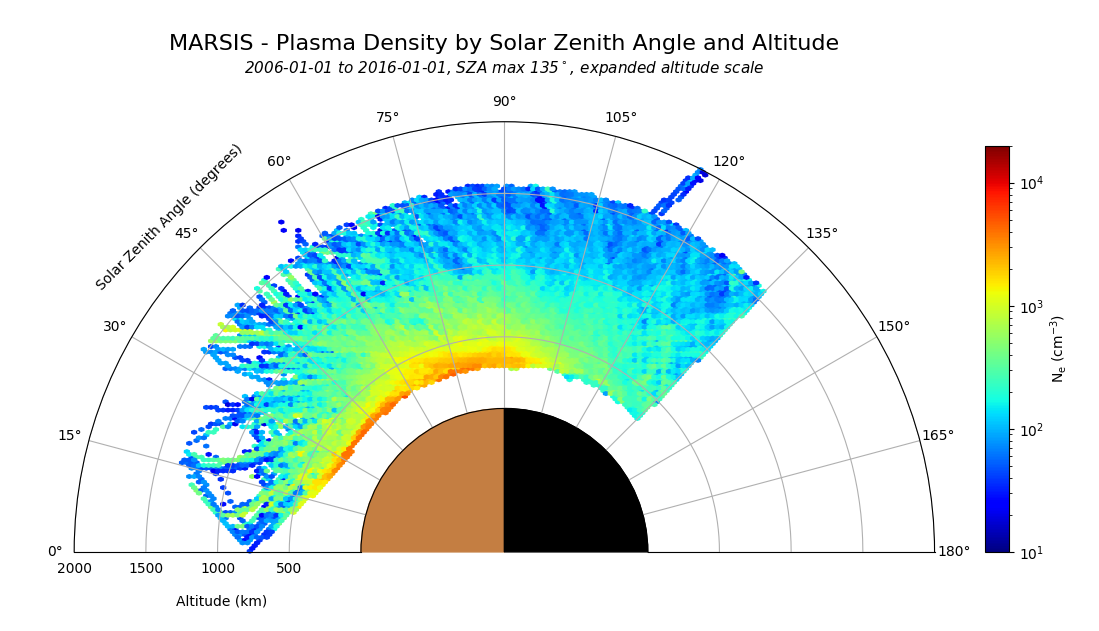Das2 servers typically provide data relevant to space plasma and magnetospheric physics research. To retrieve data, an HTTP GET request is posted to a das2 server by a client program and a self-describing stream of data values covering the requested time range, at the requested time resolution, is provided in the response body. This package, das2py provides an efficient space physics data client for python. Streams are parsed and stored as NumPy arrays using a C extension, avoiding data copies and conversions.
Pre-build versions of das2py are available from Anaconda. If you're working in an Anoconda or Miniconda python 3 environment these are easier to install as no C compiler is required. To install the conda package run the command:
(base) $ conda install -c dasdevelopers das2pyIf this works then test using:
(base) $ wget https://raw.githubusercontent.com/das-developers/das2py/master/examples/ex05_mex_marsis_query_by_angle.py
(base) $ python ex02_galileo_pws_spectra.pyIf this command produces a plot similar to the following...
...then das2py is installed, and you can skip building the software and head straight the example program below.
Compilation and installation of das2py has been tested on Linux, Windows, MacOS using both Python 2 and Python 3. The following packages are required to build das2py:
- Das2C - Version 2.3 or above. Need not be installed, but must be built
- NumPy - Version 1.10.1 or above
- MatplotLib++ - For plotting data (optional, recommended)
- SpacePy - For writing CDF files (optional)
Pre-requisite package install commands are give below.
$ sudo apt install python3-setuptools python3-dev python3-numpy # debianDecide where you want to install das2py. In the example below I've selected
/usr/local/lib/python3.6/site-packages but any location is fine so long as
it is on the PYTHONPATH or you are willing to add it to your PYTHONPATH.
# Where to find the das2C static library
$ export DAS2C_INCDIR=$HOME/git/das2C
$ export DAS2C_LIBDIR=$HOME/git/das2C/build. #last dot is not a typo
# Which python version to use
$ export PYVER=3.7
# Where you want to install the files
$ export INST_HOST_LIB=/usr/local/lib/python3.6
$ export INST_EXT_LIB=/usr/local/lib/python3.6
# Build and test
$ make
$ make test
# Check install location, then install
$ make -n install
$ make installThe following small program demonstrates how to query for data and generate a plot using das2py.
import das2
src = das2.get_source( 'tag:das2.org,2012:site:/uiowa/galileo/pws/survey_electric/das2' )
dataset = src.get( {'time' : ('1997-05-07T15:00', '1997-05-07T17:00', 4.0)} )[0] - Servers come and go. The federated catalog provides stability for application code by maping URIs to data sources.
- Browse for URIs using a das2 catalog browser, or using das2py to get the root node (see example 11).
print(dataset)
vX = dataset['time']['center']
vY = dataset['frequency']['center']
vZ = dataset['electric']['center'] - Datasets contain dimensions. Dimensions contain variables. Each variable in a dimension serves a purpose, the most common is to define the center point of a coordinate or measurement.
- Array dimensions are not confused with physical dimensions. Dataset meaning is not tied to any particular array morphology.
import matplotlib.pyplot as pyplot
import matplotlib.colors as colors
fig, ax = pyplot.subplots()
scaleZ = colors.LogNorm(vmin=vZ.array.min(), vmax=vZ.array.max())
ax.pcolormesh(vX.array, vY.array, vZ.array, norm=scaleZ, cmap='jet')
pyplot.show() Please use the github.com issue tracker report any problems with the library. If you've fixed a bug, 1) thanks!, 2) please send a pull request so that your updates can be merged into the main project.
